
Darwin’s Failed Predictions
A Response to Selected Online Materials of PBS-NOVA’s “Judgment Day: Intelligent Design on Trial” Documentary
www.judgingpbs.com
Note: This site is in no way affiliated with PBS or NOVA, and is intended as a critique of selected online materials from PBS-NOVA’s “Judgment Day: Intelligent Design on Trial” documentary, which first aired in November, 2007. PBS-NOVA’s original online materials are available at:
https://www.pbs.org/wgbh/nova/id/predictions.html
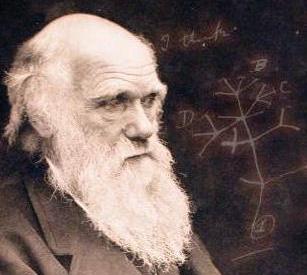
Introduction
PBS asserts that the evidence “unequivocally supports [Darwin’s] theory of evolution by natural selection.” Do all scientists who approach biology with an open mind believe that the data “unequivocally” supports Darwin’s view? The following slides show that scientists are increasingly skeptical that natural selection is the primary agent of evolutionary change. Moreover, key postulates of Darwin’s theory – universal common descent, the continuity of life, and transitions in the fossil record – have come under intense scientific scrutiny from a diverse array of fields, including molecular biology, developmental biology, genetics, biochemistry, and paleontology. Some of Darwin’s failed predictions include:
- The failure of evolutionary biology to provide detailed evolutionary explanations for the origin of complex biochemical features;
- The failure of the fossil record to provide support for Darwinian evolution;
- The failure of molecular biology to provide evidence for universal common descent;
- The failure of genetics and chemistry to explain the origin of the genetic code;
- The failure of developmental biology to explain why vertebrate embryos diverge from the beginning of development.
1. Evolution Happens So What?
PBS confidently instructs us that “evolution happens.” But should that matter? Even Darwin’s scientific critics agree that evolution happens. PBS is introducing equivocation into the discussion by failing to clearly define “evolution.”
Some use “evolution” to refer to something as simple as minor changes within individual species that occur over short periods of time (Evolution #1).
Others use the same word to mean something much more far-reaching, such as claiming that all living organisms are descended from a single common ancestor (Evolution #2), or that natural selection has the power to produce all of life’s complexity (Evolution #3).
Used one way, “evolution” isn’t controversial at all (i.e. Evolution #1); used another way, it’s hotly debated (i.e. Evolution #2 or Evolution #3). Used equivocally, “evolution” is too imprecise to be useful in a scientific discussion.
When you see the word “evolution,” you should ask yourself, “Which of the three definitions is being used?”
Critics of neo-Darwinism today usually take issue with Evolution #2 or Evolution #3. But the discussion gets confusing when a Darwinist takes evidence for Evolution #1 and tries to make it look like it supports Evolution #2 or Evolution #3. Proponents of Darwinism, including PBS, commonly pull this “Evolution” Bait-and-Switch, using evidence for small-scale changes, such as changes in the sizes of bird beaks (Evolution #1) and then over-extrapolating from such modest evidence to claim that it proves Darwin’s grander claims (Evolution #2 or Evolution #3).
Some of the above discussion is adapted from Explore Evolution.
2. Following The Evidence Wherever It Leads
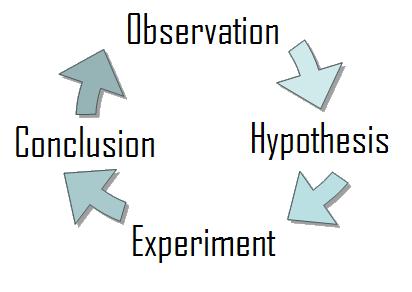
No one doubts that Darwin was a gifted scientist who made careful observations of the natural world. The same could be said for Sir Isaac Newton, an early proponent of intelligent design whose ideas inspired both modern physics and modern science as a whole.
Yet despite the long-lasting success of Newton’s ideas, technological advancements in the early 20th century overturned Newtonian physics and replaced them with Einstein’s theories. If history is to be our guide, science must always be open to following the evidence where it leads, even if that means challenging orthodoxy.
PBS urges viewers to believe that “nothing in biology makes sense except in the light of evolution.” Such a statement reverses the scientific process by putting conclusions ahead of empirical observations of nature. PBS also quotes evolutionary paleontologist Niles Eldredge, stating, “Nothing that we have learned in the intervening 175 years has contravened Darwin’s basic description of how natural selection works,” and asserting that the data “unequivocally” support Darwin’s view. Such dogmatic statements fly in the face of the scientific spirit, which opposes dogmatic attachments to theories and promises to follow the evidence wherever it may lead.
In 1998, the U.S. National Academy of Sciences printed a guide to teaching evolution that included an essay by the eminent evolutionary biologist Ernst Mayr, which stated: “One of the most characteristic features of science is this openness to challenge. The willingness to abandon a currently accepted belief when a new, better one is proposed is an important demarcation between science and religious dogma.”1 PBS may claim that evolution is open to scrutiny, but the authoritarian and one-sided treatment of the subject in “Judgment Day: Intelligent Design on Trial” shows that they treat it more like a religious dogma than a science.
Were PBS to promote the tentative, skeptical mindset that underlies all good science, their online materials would have stated, “Nothing in biology makes sense except in the light of the data.”
Reference Cited
- Ernst Mayr, “The Concerns of Science” in National Academy of Sciences, Teaching about Evolution and the Nature of Science, page 43 (National Academy Press, 1998).
3. The Role Of Natural Selection In Evolution Is Controversial Among Scientists
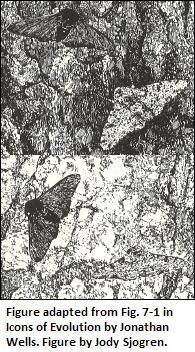
As noted in the Introduction, PBS asserts that the data “unequivocally” support the view that “[e]volution happens through natural selection.” In this dogmatic statement, PBS has again failed to clearly define “evolution.” If by “evolution,” PBS means that we can observe small-scale changes within species, then no one doubts that natural selection plays a role. But in fact, many scientists have questioned whether natural selection acting upon random mutation is sufficient to generate new species or new complex biological features. As evolutionary scientist Robert L. Carroll queries: “Can changes in individual characters, such as the relative frequency of genes for light and dark wing color in moths adapting to industrial pollution, simply be multiplied over time to account for the origin of moths and butterflies within insects, the origin of insects from primitive arthropods, or the origin of arthropods from among primitive multicellular organisms?
How can we explain the gradual evolution of entirely new structures, like the wings of bats, birds, and butterflies, when the function of a partially evolved wing is almost impossible to conceive?”1 Leading biologist Lynn Margulis, who opposes ID, also criticizes the standard Darwinian mechanism by stating that the “Darwinian claim to explain all of evolution is a popular half-truth whose lack of explicative power is compensated for only by the religious ferocity of its rhetoric.”2 She further observes that “new mutations don’t create new species; they create offspring that are impaired.”3
Stanley Salthe, author of an evolutionary biology textbook, proclaims, “I have become an apostate from Darwinian theory and have described it as part of modernism’s origination myth.”4 Evolutionary philosopher Jerry Fodor recently wrote that “at a time when the theory of natural selection has become an article of pop culture, it is faced with what may be the most serious challenge it has had so far.”5 National Academy of Sciences member Phil Skell also questions the explanatory utility of natural selection:Natural selection makes humans self-centered and aggressive – except when it makes them altruistic and peaceable. Or natural selection produces virile men who eagerly spread their seed – except when it prefers men who are faithful protectors and providers. When an explanation is so supple that it can explain any behavior, it is difficult to test it experimentally, much less use it as a catalyst for scientific discovery. Darwinian evolution – whatever its other virtues – does not provide a fruitful heuristic in experimental biology.6Indeed, over 700 doctoral scientists have signed a public statement proclaiming their agreement that, “We are skeptical of claims for the ability of random mutation and natural selection to account for the complexity of life.”7 Yet PBS presents natural selection as the “unequivocally” accepted mechanism of evolution. Clearly there are significant scientific voices who dissent from the Darwinian view. Unfortunately, their voices are left out of PBS’s one-sided discussion of evolution.
References Cited
- Robert Carroll, Patterns and Processes of Vertebrate Evolution, page 9 (Cambridge University Press, 1997).
- Lynn Margulis & Dorion Sagan, Acquiring Genomes: A Theory of the Origins of the Species, page 29 (Basic Books, 2003).
- Lynn Margulis quoted in Darry Madden, “UMass Scientist to Lead Debate on Evolutionary Theory,” Brattleboro (Vt.) Reformer (Feb 3, 2006).
- Stanley Salthe ,quoted in Discovery Institute, “40 Texas scientists join growing national list of scientists skeptical of Darwin,” September 5, 2003. Available: https://www.discovery.org/a/1555/.
- Jerry Fodor, “Why Pigs Don’t Have Wings,” London Review of Books (October 18, 2007) at https://www.lrb.co.uk/the-paper/v29/n20/jerry-fodor/why-pigs-don-t-have-wings.
- Philip S. Skell, “Why Do We Invoke Darwin? Evolutionary theory contributes little to experimental biology,” The Scientist (August 29, 2005), available at https://www.discovery.org/a/2816/.
- See “A Scientific Dissent from Darwinism,” at https://dissentfromdarwin.org/.
4. The Role Of Natural Selection In Evolution Is Controversial Among Scientists (Continued)
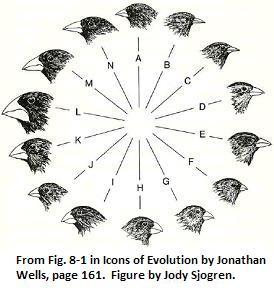
As discussed in Slide #1, proponents of Darwinism often employ the “Evolution” Bait-and-Switch, using evidence for small-scale changes and then over-extrapolating to claim that such modest evidence proves Darwin’s grander claims. In fact, this is precisely what PBS does in its online materials for “Judgment Day: Intelligent Design on Trial.”
A PBS web slide asserts, “Evolution happens through natural selection,” and then goes on to discuss small-scale changes in the sizes of beaks in finches on the Galapagos Islands as supporting evidence. Such small-scale changes do not demonstrate that natural selection can cause large-scale evolutionary changes, such as the origin of new body plans or perhaps even the origin of new species. In fact, all of the finch species in the Galapagos Islands remain so genetically similar that they can interbreed after millions of years of alleged evolutionary change.
If anything, the Galapagos finches demonstrate the limits of natural selection. Beak sizes increased during a drought, yet when the drought ended, finch-beaks predictably returned to their normal sizes. As biologist Jonathan Wells observes in Icons of Evolution, the bait-and-switch occurs when “evidence for oscillating natural selection in finch beaks is claimed as evidence for the origin of finches in the first place.”1 Are such Darwinist extrapolations warranted? According to UC Berkeley law professor and Darwin-critic Phillip Johnson, “When our leading scientists have to resort to the sort of distortion that would land a stock promoter in jail, you know they are in trouble.”2
References Cited
- Jonathan Wells, Icons of Evolution: Why Much of what we teach about evolution is wrong, page 174 (Regnery, 2000).
- Phillip Johnson, “The Church of Darwin,” The Wall Street Journal (August, 16, 1999).
5. Opening Darwin’s Black Box
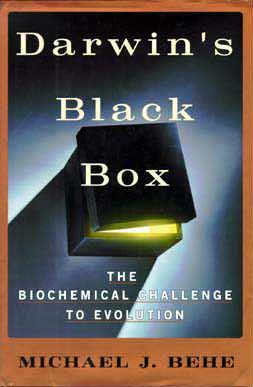
“Darwin was ignorant of the reason for variation within a species,” writes Lehigh University biochemist Michael Behe in his book Darwin’s Black Box, “but biochemistry has identified the molecular basis for it.”1 There were other things that Darwin did not know. For example, Darwin assumed that the cell was like a primitive blob of protoplasm that could easily evolve new biological functions. As Behe explains, “To Darwin, then, as to every other scientist of the time, the cell was a black box. … The question of how life works was not one that Darwin or his contemporaries could answer.”2
Modern technology has allowed biochemists to open Darwin’s black box, revealing a micro-world of mind-boggling complexity. Even leading proponents of evolution have acknowledged this complexity. Past U.S. National Academy of Sciences President Bruce Alberts has described this complexity in the journal Cell as an elaborate factory: “The entire cell can be viewed as a factory that contains an elaborate network of interlocking assembly lines, each of which is composed of a set of large protein machines.”3
But could such integrated complexity evolve in a stepwise, Darwinian fashion? Behe recalls that in Origin of Species, Darwin admitted that if “any complex organ existed which could not possibly have been formed by numerous, successive, slight modifications, my theory would absolutely break down.”4 According to Behe, “by opening the ultimate black box, the cell,” modern biochemistry “has pushed Darwin’s theory to the limit.”5
The simplest cell requires hundreds of genes, numerous complex biological machines and biochemical pathways, and a fully functional genetic code in order to survive. Darwinian evolution – blind natural selection acting on random mutations – has failed to provide Darwinian explanations for how basic cellular biochemistry might have evolved. Five years after Behe published Darwin’s Black Box, biochemist Franklin Harold stated an Oxford University Press monograph that “there are presently no detailed Darwinian accounts of the evolution of any biochemical or cellular system, only a variety of wishful speculations.”6
References Cited
- Michael J. Behe, Darwin’s Black Box: The biochemical challenge to evolution, page X (Free Press, 1996).
- Michael J. Behe, Darwin’s Black Box: The biochemical challenge to evolution, pages 9-10 (Free Press, 1996).
- Bruce Alberts, “The Cell as a Collection of Protein Machines: Preparing the Next Generation of Molecular Biologists,” Cell, Vol. 92:291 (February 8, 1998).
- Charles Darwin, Origin of Species (1859), Chapter 6, available at https://www.literature.org/authors/darwin-charles/the-origin-of-species/chapter-06.html.
- Michael J. Behe, Darwin’s Black Box: The biochemical challenge to evolution, page 15 (Free Press, 1996).
- Franklin M. Harold, The Way of the Cell: Molecules, Organisms and the Order of Life, page 205 (Oxford University Press, 2001).
6. Darwinism: Grounded in Science
PBS observes that the famous 19th century naturalist, T.H. Huxley, declared that “evolution excludes creation and all other kinds of supernatural intervention.” But modern Darwinists have gone much further than Huxley. In Proceedings for the National Academy of Sciences, leading evolutionary biologist Francisco Ayala celebrates that “Darwin’s greatest accomplishment” was to show that the origin of life’s complexity “can be explained as the result of a natural process-natural selection-without any need to resort to a Creator or other external agent.”1
America’s great champion of evolution, the late Stephen Jay Gould, similarly announced that “[b]efore Darwin, we thought that a benevolent God had created us,”2 but because of Darwin’s ideas, “biology took away our status as paragons created in the image of God.”3 Richard Dawkins is Oxford University’s Charles Simonyi Professor for the Public Understanding of Science and is probably the most famous evolutionist in the world. Yet Dawkins believes that God is a “delusion” and that “Darwin made it possible to become an intellectually fulfilled atheist.”6
Gould’s and Dawkins’s views are by no means uncommon among leading scientists. A 2007 editorial by the editors of the world’s top scientific journal, Nature, stated that “the idea that human minds are the product of evolution” is an “unassailable fact,” and thus concluded, “the idea that man was created in the image of God can surely be put aside.”4
Also noteworthy is the fact that key public defenders of Darwin involved in the Dover trial who were featured in PBS’s “Judgment Day: Intelligent Design on Trial” documentary have strong ties to secular humanist groups. For example, Eugenie Scott is Executive Director of the National Center for Science Education. She is also a public signer of the Third Humanist Manifesto, an aggressive statement of the humanist agenda to create a world with “without supernaturalism” based upon the view that “[h]umans are- the result of unguided evolutionary change” and the universe is “self-existing.”5 Similarly, Dover plaintiffs’ expert Barbara Forrest, also featured in the PBS show, is a long time board member of the New Orleans Secular Humanist Association.
Indeed, PBS-NOVA’s star theistic evolutionary biologist Ken Miller has claimed in five editions of his textbooks that evolution works “without either plan or purpose” and is “random and undirected.”7 Two additional editions of Miller’s textbooks state: “Darwin knew that accepting his theory required believing in philosophical materialism, the conviction that matter is the stuff of all existence and that all mental and spiritual phenomena are its by-products.”8 Harvard paleontologist and author Richard Lewontin explains how this materialism is an overriding assumption propping Darwinian thought: “[W]e have a prior commitment – to materialism. It is not that the methods and institutions of science somehow compel us to accept a material explanation of the phenomenal world, but, on the contrary, that we are forced by our a priori adherence to material causes to – produce material explanations- [T]hat materialism is absolute, for we cannot allow a Divine Foot in the door.”9 Finally, leading Darwinian philosopher of science Michael Ruse admits that “for many evolutionists, evolution has functioned – akin to being a secular religion” whose main doctrine is “a commitment to a kind of naturalism.”10 Is it possible that there is more propping up the support of Darwinism than the mere empirical evidence?
References Cited
- Francisco J. Ayala, “Darwin’s greatest discovery: Design without designer,” Proceedings of the National Academy of Sciences USA, Vol. 104:8567-8573 (May 15, 2007) (emphasis added).
- Stephen Jay Gould, Ever Since Darwin: Reflections in Natural History, page 267 (W.W. Norton, 1977).
- Stephen Jay Gould, Ever Since Darwin: Reflections in Natural History, page 147 (W.W. Norton, 1977).
- “Evolution and the brain,” Nature, Vol. 447:753 (June 14, 2007).
- “Humanism and its Aspirations,” at https://americanhumanist.org/what-is-humanism/manifesto3/.
- Richard Dawkins, The Blind Watchmaker, page 6 (W. W. Norton, 1986).
- Kenneth R. Miller & Joseph S. Levine, Biology (1st ed., Prentice Hall, 1991), pg. 658; (2nd ed., Prentice Hall, 1993), pg. 658; (3rd ed., Prentice Hall, 1995), pg. 658; (4th ed., Prentice Hall, 1998), pg. 658; (5th ed. Teachers Ed., Prentice Hall, 2000), pg. 658.
- Kenneth R. Miller & Joseph S. Levine, Biology: Discovering Life (1st ed., D.C. Heath and Co., 1992), pg. 152; (2nd ed.. D.C. Heath and Co., 1994), p. 161; emphasis in original.
- Richard Lewontin, “Billions and Billions of Demons,” New York Review of Books, page. 28 (January 9, 1997).
- Michael Ruse, “Nonliteralist Antievolution” AAAS Symposium: “The New Antievolutionism,” February 13, 1993, Boston, MA (1993).
7. Evolving Views Of Embryology
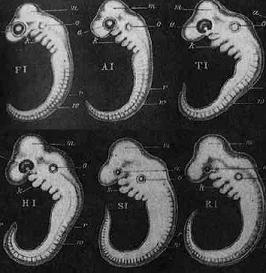
PBS observes that Darwin boasted that embryology provided “the strongest single class of facts in favor of” his theory of evolution. But Darwin penned those words in the 1860s, and developmental biologists have learned much since that time. In fact, Darwin staked much of his evidential support upon the work of the 19th century embryologist Ernst Haeckel. After Darwin, it was discovered that Haeckel promoted fraudulent data to falsely support vertebrate common ancestry by overstating the similarities between vertebrate embryos in their earliest stages of development.
Haeckel’s infamous embryo drawings obscured the differences between vertebrate embryos in their earliest stages, leading to widespread belief in the false idea that “ontogeny recapitulates phylogeny” (i.e. development replays evolutionary history). The factual data reveal that vertebrate embryos develop very differently from their earliest stages in a pattern that is unexpected if all vertebrates share a common ancestor. Darwin himself was a victim of Haeckel’s fraud, and had Darwin known the truth, perhaps he might never have made the statement that PBS quotes above.
But there are even stronger reasons to understand that modern developmental biology challenges Darwin. Biologists have discovered, as PBS puts it, that “microbes to man … share a common ‘tool kit’ of so-called master genes.” PBS claims this supports Darwinian evolution because living animal groups inherited these genes from a common ancestor. While intelligent design is certainly compatible with common ancestry, PBS ignores the possibility that such recurring fundamental genetic programs across species could also be explained as the result of common design, i.e. the re-usage of genetic programs that fulfill the functional requirements of animal development. Indeed, common design may be the best explanation for the many instances where these master genes control the growth of analogous body parts in widely diverse organisms where it is even not thought that the common ancestor even had the body part in question.
For example, vertebrates, sea urchins, insects, and various other invertebrate groups all use the same regulatory genes to control growth of their widely diverse types of limbs, but it is not thought that their common ancestor had a common limb. Similarly, vertebrates, insects, and jellyfish use similar master control genes to control the development of their widely different eyes, but their alleged common ancestor is not thought to have had a common type of eye. In these cases, living animal groups would NOT be expected to have inherited their genetic “tool kits” from a common ancestor because there is no reason to believe that the common ancestor was using that genetic toolkit for some common body part. As Wolf-Ekkehard Loennig, plant geneticist at the Max Planck Institute for Genetics writes, “No theorist in evolutionary biology will ever derive chicken and insects from a winged common ancestor, and yet, clearly related sequences are specifically expressed in wing buds and imaginal disks.”1
Darwinists try to resolve such quandaries by appealing to extreme examples of convergent genetic evolution, what one might term genetic predestination. But such examples of extreme convergence strain the credulity of Darwin’s mechanism. Can blind and undirected natural selection cause many animal groups to independently deploy precisely the same genetic toolkits for development? Such a high level of genetic similarity seems highly unlikely to evolve independently numerous times in the history of life.
Reference Cited
- Wolf-Ekkehard Loennig, “Dynamic genomes, morphological stasis, and the origin of irreducible complexity,” in Dynamical Genetics pages. 101-119 (Valerio Parisi, Valeria De Fonzo, and Filippo Aluffi-Pentini eds., 2004) (quoting Cohn M.J., and Tickle, C. 1996, Trends Genet. 12, 253-257).
8. Why Sexual Selection?

According to PBS, the male peacock’s beautifully-colored tail is easily explained using sexual selection: females prefer the colorful “eyes” on the tails of males. Has the evolutionary origin of the peacock’s tail been explained?
Sexual selection merely pushes the question back: why should female peacocks prefer male peacocks with tails that have “eyes”? Absent a linkage to survival and reproduction, sexual selection is now a circular argument: male peacocks have beautiful tails because females prefer such tails, and females prefer such tails because they are, well, beautiful. Under sexual selection, explanations become arbitrary because traits are preferred simply because a biologist deems them “attractive.” But sexual selection rarely provides an external adaptive reason to explain why such traits should be “beautiful” to the opposite sex.
Despite its ability to arbitrarily select for virtually any trait wished for, sexual selection has been invoked to account for the evolutionary origin of humanity’s most cherished abilities, including art, literature, music, mathematics, religious belief, and even scientific genius. Once you define something as “beautiful” or “attractive,” the magic wand of sexual selection can produce virtually anything an evolutionary biologist wants.
But there is a more fundamental problem here: the existence of sexual selection itself begs the very question, why are there male and female peacocks at all?, i.e. why did sexual reproduction evolve in the first place? Sexual organisms only pass on 50% of their genes to offspring, whereas asexual organisms make clones that contain 100% of the parent’s DNA. Thus organisms that hypothetically evolved sexual selection suddenly experienced a 50% drop in fitness. The fitness cost of sexual reproduction is further explained in the critical response to the PBS Evolution series, Getting the Facts Straight: “The very existence of sexual reproduction presents a problem for Darwin’s theory. The easiest way for an organism to reproduce is simply to divide asexually– to make a copy of itself. Bacteria are very successful at this. An organism that reproduces sexually, however, must divert precious energy into making sperm or egg cells; in the process, gene combinations that were quite useful beforehand are sometimes destroyed through ‘recombination.’ Then the organism must find a member of the opposite sex and mate with it successfully. From an evolutionary perspective, sex incurs considerable costs that must be offset by advantages to the organism.”1The online materials for PBS-NOVA’s “Judgment Day: Intelligent Design on Trial” documentary mentions none of these obstacles facing the origin of sexual reproduction.
Reference Cited
- Getting the Facts Straight: A Viewer’s Guide to PBS’s Evolution, page 73 (Discovery Institute Press, 2001), at https://www.discovery.org/f/90112/.
9. Saving the Tree of Life

PBS asserts that “shared amino acids” in genes common to many types of organisms indicate that all life shares a common ancestor. Intelligent design is not necessarily incompatible with common ancestry, but it must be noted that intelligent agents commonly re-use parts that work in different designs. Thus, similarities in such genetic sequences may also be generated as a result of functional requirements and common design rather than by common descent.
In fact, PBS’s statement is highly misleading. Darwin’s tree of life–the notion that all living organisms share a universal common ancestor–has faced increasing difficulties in the past few decades. Phylogenetic trees based upon one fundamental gene or protein often conflict with trees based upon another gene or protein. In fact, this problem is particularly acute when one studies the “ancient” genes at the base of the tree of life, which PBS wrongly claims demonstrate universal common ancestry. As W. Ford Doolittle explains, “[m]olecular phylogenists will have failed to find the ‘true tree,’ not because their methods are inadequate or because they have chosen the wrong genes, but because the history of life cannot properly be represented as a tree.”1
Doolittle, a Darwinian biologist, elsewhere writes that “there would never have been a single cell that could be called the last universal common ancestor.”2 Doolittle attributes his observations to gene-swapping among microorganisms at the base of the tree. But Carl Woese, the father of evolutionary molecular systematics, finds that such problems exist beyond the base of the tree: “Phylogenetic incongruities [conflicts] can be seen everywhere in the universal tree, from its root to the major branchings within and among the various taxa to the makeup of the primary groupings themselves.”3
Looking higher up the tree, a recent study conducted by Darwinian scientists tried to construct a phylogeny of animal relationships but concluded that “[d]espite the amount of data and breadth of taxa analyzed, relationships among most [animal] phyla remained unresolved.”4 The basic problem is that phylogenetic trees based upon one gene or other characteristic will commonly conflict with trees based upon another gene or macro-characteristic. Indeed, the Cambrian explosion, where nearly all of the major living animal phyla (or basic body plans) appeared over 500 million years ago in a geological instant, raises a serious challenge to Darwinian explanations of common descent.
The nice, neat, nested hierarchy of a grand Tree of Life predicted by Darwinian theory has not been found. Evolutionary biologists are increasingly appealing to epicycles like horizontal gene transfer, differing rates of evolution, abrupt molecular radiation, convergent evolution (even convergent molecular evolution), and other ad hoc rationalizations to reconcile discrepancies between phylogenetic hypothesis. Darwinian biology is not explaining the molecular data; it is forced to explain away the data. PBS paints a rosy picture of the data, when the data isn’t good news for Darwinism.
References Cited
- W. Ford Doolittle, “Phylogenetic Classification and the Universal Tree,” Science, Vol. 284:2124-2128 (June 25, 1999).
- W. Ford Doolittle, “Uprooting the Tree of Life,” Scientific American, pages 90-95 (February, 2000).
- Carl Woese “The Universal Ancestor,” Proceedings of the National Academy of Sciences USA, Vol. 95:6854-9859 (June, 1998).
- Antonis Rokas, Dirk Krueger, Sean B. Carroll, “Animal Evolution and the Molecular Signature of Radiations Compressed in Time,” Science, Vol. 310:1933-1938 (Dec. 23, 2005).
10. The Myth of 1% Human-Chimp Genetic Differences
As if trying to suggest that those who question human-chimp common ancestry are ignorant, PBS asserts that “a schoolchild can cite the figure perhaps most often called forth in support of [human/chimp common ancestry]–namely, that we share almost 99 percent of our DNA with our closest living relative, the chimpanzee.” Such an argument raises two questions:
(1) Is the 99% Human/Chimp DNA-similarity statistic accurate? While recent studies have confirmed that certain stretches of human and chimp DNA are on average about 1.23% different, this is merely an estimate with huge caveats. A recent news article in Science observed that the 1% figure “reflects only base substitutions, not the many stretches of DNA that have been inserted or deleted in the genomes.”1 In other words, when the chimp genome has no similar stretch of human DNA, such DNA sequences are ignored by those touting the statistic that humans and chimps are only 1% genetically different. For this reason, the aforementioned Science news article was subtitled “The Myth of 1%,” and printed the following language to describe the 1% statistic: “studies are showing that [humans and chimps] are not as similar as many tend to believe”; the 1% statistic is a “truism [that] should be retired”; the 1% statistic is “more a hindrance for understanding than a help”; “the 1% difference wasn’t the whole story”; “Researchers are finding that on top of the 1% distinction, chunks of missing DNA, extra genes, altered connections in gene networks, and the very structure of chromosomes confound any quantification of ‘humanness’ versus ‘chimpness.'” Indeed, due to the huge caveats in the 1% statistic, some scientists are suggesting that a better method of measuring human/chimp genetic differences might be counting individual gene copies. When this metric is employed, human and chimp DNA is over 5% different. But new findings in genetics show that gene-coding DNA might not even be the right place to seek differences between humans and chimps.
But there is a deeper question: (2) If humans and chimps were truly only 1% different at the genetic level, why should that demonstrate common ancestry? As noted in Slide 9, similarities in key genetic sequences may be explained as a result of functional requirements and common design rather than mere common descent. We might reasonably ask the evolutionist why the 1% difference value is considered powerful evidence for Darwinian evolution, and at what point does the comparison cease to support Darwinian evolution? What about 2% different? 3%? 5%? 10%? Is there an objective metric for falsification here, or is PBS putting forth a fallacious argument for human / chimp common ancestry?
Intelligent design is certainly compatible with human/ape common ancestry, but the truth is that the percent difference says nothing about whether humans and chimps share a common ancestor. The percent genetic similarity between humans and apes does not demonstrate Darwinian evolution, unless one excludes the possibility of intelligent design.
Just as intelligent agents ‘re-use’ functional components that work over and over in different systems (e.g., wheels for cars and wheels for airplanes), genetic similarities between humans and chimps could also be explained as the result of the re-usage of common genetic programs due to functional requirements of the hominid body plan.
Reference Cited
- Jon Cohen, “Relative Differences: The Myth of 1%,” Science, Vol. 316:1836 (June 29, 2007).
11. Human Evolution Remains A Mystery
In 1980, the famed late evolutionary paleontologist Stephen Jay Gould noted that, “[m]ost hominid fossils, even though they serve as a basis for endless speculation and elaborate storytelling, are fragments of jaws and scraps of skulls.”1 PBS confidently asserts that our species, Homo sapiens, evolved from ape-like species, but the fossil record tells a different story. The fossil record contains two basic types of hominids: those that can be classified as ape-like and those that can be classified as modern human-like. But there remains a distinct break in the morphology of ape-like species and human-like species that is not bridged by our knowledge of the fossil record.
For example, PBS touts Lucy, a member of the hominid species Australopithecus afarensis, as a representative of humanity’s ancestors. But many studies have found that the australopithecines were more similar to modern apes than to modern humans. For example, Lucy is commonly called a precursor to the bipedal form of human locomotion, yet one study found Lucy had handbones like a knuckle-walking ape. Another study wrote, “We, like many others, interpret the anatomical evidence to show that early H[omo] sapiens was significantly and dramatically different from earlier and penecontemporary australopithecines in virtually every element of its skeleton and every remnant of its behavior.”2
These rapid, unique, and genetically significant changes were called “a genetic revolution” where “no australopithecine species is obviously transitional.”2 One commentator proposed this evidence implies a “big bang theory” of human evolution.3 Similarly, two paleoanthropologists stated in Nature that the first human-like fossils appear so suddenly in the record that “it is hard at present to identify its immediate ancestry in east Africa. Not for nothing has it been described as a hominin ‘without an ancestor, without a clear past.'”4
A Harvard evolutionary paleoanthropologist recently stated in the New York Times that newly discovered hominid fossils “show ‘just how interesting and complex the human genus was and how poorly we understand the transition from being something much more apelike to something more humanlike.'”5 Such an admission was echoed soon thereafter by a different set of evolutionary paleoanthropologists stating that “we know nothing about how the human line actually emerged from apes.”6 While these researchers undoubtedly themselves support the view that humans and apes share a common ancestor, perhaps PBS would do best to explain that there are many unsolved mysteries about human origins, rather than presenting the united front that humans are unequivocally descended from ape-like species: The truth is that skeptics of human evolution have ample scientific justification for their views.
References Cited
- Stephen Jay Gould, The Panda’s Thumb, page 126 (W.W. Norton, 1980).
- J. Hawks, K. Hunley, L. Sang-Hee, and M. Wolpoff, “Population Bottlenecks and Pleistocene Evolution,” Journal of Molecular Biology and Evolution, Vol. 17(1): 2-22 (2000).
- University of Michigan News and Information Services News Release, “New study suggests big bang theory of human evolution” (January 10, 2000), available at https://news.umich.edu/new-study-suggests-big-bang-theory-of-human-evolution/.
- Robin Dennell & Wil Roebroeks, “An Asian perspective on early human dispersal from Africa,” Nature, Vol. 438:1099-1104 (Dec. 22/29, 2005).
- Daniel Lieberman, quoted in “Fossils in Kenya Challenge Linear Evolution,” by John Noble Wilford, New York Times (August 9, 2007), at https://www.nytimes.com/2007/08/09/science/09fossil.html.
- Scientists quoted in “Fossil find pushes human-ape split back millions of years,” (August 24, 2007), at www.breitbart.com/article.php?id=070824121653.65mgd37f&show_article=1.
12. The Origin Of Life Remains A Mystery
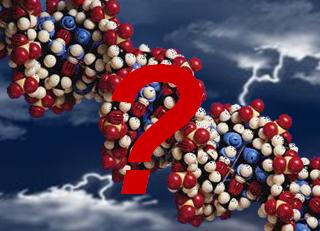
If, as Slide 11 suggests, human origins are a mystery to Darwinian scientists, the chemical origin of life presents a far greater challenge. As Gregg Easterbrook recently wrote in Wired Magazine, “What creates life out of the inanimate compounds that make up living things? No one knows. How were the first organisms assembled? Nature hasn’t given us the slightest hint. If anything, the mystery has deepened over time.”1
Origin of life theorists have struggled simply to account for the origin of pre-biological organic chemicals on the early earth, with little success. So drastic is the evidence against pre-biotic synthesis, that in 1990 the Space Studies Board of the National Research Council recommended that origin of life scientists undertake a “reexamination of biological monomer synthesis under primitive Earthlike environments, as revealed in current models of the early Earth.”2 But this is only the beginning of the problem, as leading origin of life theorist Stanley Miller once admitted that “making compounds and making life are two different things.”3
When trying to “make” the first life-form, scientists cannot rely upon Darwinian processes. Darwinian evolution requires replication, and prior to the origin of life there was no replication. Origin of life theorist Robert Shapiro explains that an explanation for the first self-replicating molecule “has not yet been described in detail or demonstrated” but “is taken for granted in the philosophy of dialectical materialism.”4
Accounting for the origin of a self-replicating molecule would still not explain how modern cells arose. Our DNA code requires an irreducibly complex system requiring the information in DNA, the enzymes that assist DNA’s replication and protection, a protective cell membrane, and a complex system of machinery used to transcribe and translate language of DNA into protein. Faced with the complexity of this system, biologist Frank Salisbury lamented in 1971 that “the entire system must come into being as one unit, or it is worthless. There may well be ways out of this dilemma, but I don’t see them at the moment.”5
In 1995, leading biologists John Maynard Smith and Eors Szathmary explained that accounting for the origin of this system remains “perhaps the most perplexing problem in evolutionary biology” because “the existing translational machinery is at the same time so complex, so universal and so essential that it is hard to see how it could have come into existence or how life could have existed without it.”6
Scientists may one day create life in the lab. But they will have done so using intelligent design. The theory that life could have originated via blind natural chemical processes relying upon sheer dumb luck remains unexplained.
References Cited
- Gregg Easterbrook, “Where did life come from?,” Wired Magazine, page 108 (February, 2007).
- National Research Council Space Studies Board, The Search for Life’s Origins (National Academy Press: Washington D.C., 1990).
- Statements made by Stanley Miller at a talk given by him for a UCSD Origins of Life seminar class on January 19, 1999.
- Robert Shapiro, Origins: A Skeptics Guide to the Creation of Life on Earth, page 207 (Summit Books, 1986).
- Frank B. Salisbury, “Doubts about the Modern Synthetic Theory of Evolution,” page. 338, American Biology Teacher (September, 1971).
- John Maynard Smith and Eors Szathmary, The Major Transitions in Evolution, page. 81 (W.H. Freeman, 1995).
13. The Abrupt Appearance Of Biological Forms
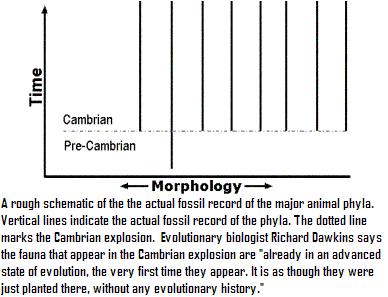
PBS has a slide stating that evolutionary paleontologists “continue to unearth key fossils that bridge those gaps Darwin bemoaned.” But evolutionary paleontologist David Raup wrote in 1979 that “we are now about 120 years after Darwin, and knowledge of the fossil record has been greatly expanded … ironically, we have even fewer examples of evolutionary transition than we had in Darwin’s time.”1
PBS asserts that fossils discovered in the “past half century” have “filled in” gaps to explain the Cambrian explosion in evolutionary terms. Yet a textbook published just six years ago acknowledges that the fossil record has not given clues to help explain the origin of animal phyla in the Cambrian explosion:
“Most of the animal phyla that are represented in the fossil record first appear, ‘fully formed,’ in the Cambrian some 550 million years ago…The fossil record is therefore of no help with respect to the origin and early diversification of the various animal phyla.”2
But this is not the only such “explosion” in the fossil record. Paleontologists have observed a fish explosion, a plant explosion, a bird explosion, and even a mammal explosion. Abrupt explosions of mass biological diversity seem to be the rule, not the exception, for the fossil record. Transitions plausibly documented by fossils seem to be the rare exception. As leading evolutionary biologist, the late Ernst Mayr, wrote in 2001, “When we look at the living biota, whether at the level of the higher taxa or even at that of the species, discontinuities are overwhelmingly frequent. . . . The discontinuities are even more striking in the fossil record. New species usually appear in the fossil record suddenly, not connected with their ancestors by a series of intermediates.”3
This phenomenon exists not only at the species level but also at the level of higher taxa, as one zoology textbook discusses:”Many species remain virtually unchanged for millions of years, then suddenly disappear to be replaced by a quite different, but related, form. Moreover, most major groups of animals appear abruptly in the fossil record, fully formed, and with no fossils yet discovered that form a transition from their parent group.”4 Rather than acknowledging the general pattern of explosions in the fossil record, PBS focuses on the few occasions where there are possible transitional forms. PBS focuses on Tiktaalik, an alleged transition between fish and amphibians, but Tiktaalik has a completely finlike fin and does virtually nothing to document the key aspect of the alleged fish to amphibian transition, the transformation of fins into feet.
PBS also cites Archaeopteryx as an alleged transition between dinosaurs and birds. But Archaeopteryx is generally regarded as a true bird, and its alleged dinosaurian ancestors are only known from one locality–the Yixian formation in China–which is “at least 20 Myr younger than Archaeopteryx.”5 If Archaeopteryx is the first known true bird, then from what, if anything, did birds evolve? The fossil record does not tell us. Despite the problems with this evolutionary story, Phillip Johnson provides a lucid and charitable analysis of the importance of this fossil: “Archaeopteryx is on the whole a point for Darwinists, but how important is it? Persons who come to the fossil evidence as convinced Darwinists will see a stunning confirmation, but skeptics will see a lonely exception to a consistent pattern of fossil disconfirmation.”6
References Cited
- David Raup, “Conflicts Between Darwin and Paleontology”, Field Museum of Natural History Bulletin, Vol. 50 (1) (1979).
- R.S.K. Barnes, P. Calow & P.J.W. Olive, The Invertebrates: A New Synthesis, pages 9-10 (3rd ed., Blackwell Sci. Publications, 2001).
- Ernst Mayr, What Evolution Is, page 189 (Basic Books, 2001).
- C.P. Hickman, L.S. Roberts, and F.M. Hickman, Integrated Principles of Zoology, page 866 (Times Mirror/Moseby College Publishing, 1988, 8th ed).
- Carl C. Swisher III, Yuan-qing Wang, Xiao-lin Wang, Xing Xu, and Yuan Wang, “Cretaceous age for the feathered dinosaurs of Lianoing, China” Nature, Vol. 400: 58-61 (July 1, 1999).
- Phillip E. Johnson, Darwin on Trial, page 81 (Intervarsity Press, 1993).
14. What would Darwin do?
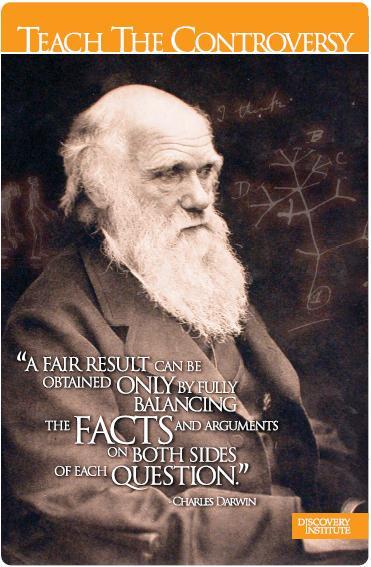
PBS presents a thoroughly pro-Darwin only account of the debate over evolution. In fact, there are many reasons why we should teach the controversy over Darwinian evolution:
(1) Congress supports such a policy: “The Conferees recognize that a quality science education should prepare students to distinguish the data and testable theories of science from religious or philosophical claims that are made in the name of science. Where topics are taught that may generate controversy (such as biological evolution), the curriculum should help students to understand the full range of scientific views that exist, why such topics may generate controversy, and how scientific discoveries can profoundly affect society.”1
(2) The United States Supreme Court has sanctioned such a policy: “We do not imply that a legislature could never require that scientific critiques of prevailing scientific theories be taught.”2
(3) Darwin himself supports such a policy: In Origin of Species, Darwin stated, “A fair result can be obtained only by fully stating and balancing the facts and arguments on both sides of each question.”3
PBS’s propaganda doesn’t even employ the approach that Darwin himself purportedly recommends. Viewers of PBS’s “Judgment Day: Intelligent Design on Trial” documentary will do well to learn about both sides of this debate.
References cited
- Conference report to No Child Left Behind Act; House Committee of Conference, Report to Accompany H.R. 1, 107th Cong. 1st sess., 78 (2001) H. Rept. 334, 78 (emphasis added). This language was originally supported by a 91-8 vote by the U.S. Senate.
- Edwards v. Aguillard, 482 U.S. 578, 593 (1987).
- Charles Darwin, Origin of Species (1859), Introduction, available at https://www.literature.org/authors/darwin-charles/the-origin-of-species/introduction.html